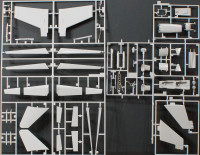
Hasegawa 1/48 F/A-18A Hornet 'NASA' Kit First Look
By Michael Benolkin
| Date of Review | November 2014 | Manufacturer | Hasegawa |
|---|---|---|---|
| Subject | F/A-18A Hornet 'NASA' | Scale | 1/48 |
| Kit Number | 07384 | Primary Media | Styrene, Photo Etch |
| Pros | Best Hornet kit in 1/48 scale | Cons | Nothing noted |
| Skill Level | Experienced | MSRP (USD) | $84.95 |
First Look
 |
 |
 |
 |
The history of the F/A-18 Hornet program is colorful to say the least. After recovering from the financial and schedule impacts from the mandated F-111B program and gaining the most capable fleet defense fighters in history with the resulting F-14 Tomcat, the Navy was still faced with replacing the F-4s on those aircraft carriers that were not capable of embarking the F-14 as well as replacing the aging fleet of A-7E Corsair II strike aircraft.
At the time, the Air Force was in full swing with its lightweight fighter program that pitted the General Dynamics YF-16 against the Northrop YF-17. The Navy was considering a purchase of the same type that won the Air Force's competition, but when the YF-16 was declared the winner, the Navy had second thoughts. The YF-16 had some inherent problems at the time, not the least of which was only one engine. The Navy decided to base their next fighter on the YF-17 Cobra. During the acquisition process for this new aircraft, McDonnell Douglas was selected to convert the YF-17 into a carrier-capable lightweight fighter while Northrop became a subcontractor to support their design. The conversion process turned out to be more difficult as time progressed as the Navy added requirements to the aircraft and these requirements translated into additional weight and cost. The resulting airframe was quite different from the original YF-17 and nearly 7,000 pounds heavier at empty weight.
The F/A-18A was the Navy's first 'swing fighter' which meant that the aircraft was capable of switching to an air superiority role without dumping its bomb load during a strike mission. Despite its short range, the aircraft demonstrated significant combat capability and was eventually adopted not only by the US Navy and US Marine Corps, but also the air arms of Australia, Canada, and Spain. Other nations have adopted the later F/A-18C Hornet in their ranks. The F/A-18A was updated with the APG-73 radar as carried by the F/A-18C and is designated as F/A-18A+.
Hasegawa has made some wise investments in kit tooling over the past few decades. The F-4 Phantom II series and the F-14 Tomcats continue to sell as Hasegawa continued to turn out reissues of each variant with different decals. The F-14 was a super-detailer's dream and fortunately Hasegawa applied that kit design philosophy into their family of F/A-18 Hornets.
The upper fuselage is molded in one part with the upper wing halves molded in-place. This makes the job of assembly and alignment SO much easier. The rest of the kit is presented on six parts trees (duplicate trees not shown) plus a single tree of clear parts, one set of white metal landing gear struts, and one fret of photo-etched parts. The details on the surface of the model are finely scribed without being unrealistic. The mold is set up to support and and two-seat Hornets. The cockpit tub is a two-holer where the rear pit is merely covered over with a plug and canopy fairing. The design of this kit is quite impressive which allowed Hasegawa to render all the different variants of the 'Bug' with minimal differences in parts.
Among the features and options in this kit:
- Nicely detailed cockpit with choice of two types of instrument panel
- Optional pilot figure
- Positionable boarding ladder
- Positionable canopy
- Very detailed landing gear with positionable catapult bar
- Positionable landing gear
- Positionable ailerons
- Positionable stabilators
- Positionable rudders
- Positionable leading edge flaps
- Positionable trailing edge flaps
- Positionable speed brake
- Vertical stab reinforcement braces provided
Since this kit represents one of NASA's test aircraft, external stores are not usually carried. The kit does provide three external fuel tanks (two underwing plus one centerline) and even a buddy refueling pod.
Markings are provided for two examples:
- F/A-18A, 161703, 850/N850NA, NASA Dryden, 2005
- F/A-18A, 151520, 847/-, NASA Dryden, 2003
The Hasegawa Hornets remain the best kits of the subject in 1/48 scale and even if you don't want to build a test jet, this kit has the parts for the service aircraft including targeting pod so you just need aftermarket decals and weapons to render whatever early bug interests you. While a few companies have also released the Hornet in 1/48 scale, nobody has done it better to date.
My sincere thanks to Hasegawa USA for this review sample!







